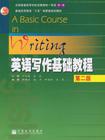英语写作基础教程
2005-7
高等教育出版社
丁往道
286
480000
无
《英语写作基础教程》是为高等学校英语专业的学生编写的,同时适合师专、广播电视大学、成人高校的英语专业使用,也可供英语水平相近的自学者参考。 《英语写作基础教程》1998年出版后,因读者需要,每年都重印,至2005年4月,已经达到18印次,并于2001年、2002年分别获北京市高等教育教学成果一等奖、国家级教学成果二等奖、全国普通高等学校优秀教材一等奖。2003年我们又推出了此书的网络版,教学内容分基础写作、实用写作和论文写作3部分(包括原书的第二、三、六、七章)。为了更好地帮助学生掌握英语写作的基础知识和基本技巧,切实提高英语写作水平和英语整体水平,网络版除了增加了不少范例外,还补充了许多练习,同时考虑网上学习的特点,我们为部分练习提供了参考答案。 这次修订,我们多方听取了使用者的意见,一方面保持了原书实用、多举范例、难度适中、符合有关大纲要求的四大特点,吸收网络版的长处;一方面改进不足、全面提高。 一、我们将原书的第八章 “文稿格式和标点符号” 提前到第一章,以便学习者一开始就了解英语写作规范,帮助他们养成正确的写作习惯,为今后的学习打下良好的基础。 二、对原书内容全面更新,如词典部分尽可能提供最新版本的信息,论文部分采用国外英语论文通用的格式。 三、本次修订最主要的工作之一就是新增了大量的练习和部分参考答案。练习分Task和Assignment两种,前者供课堂上使用,后者为课后作业。写作课是实践课,要想写得好,只有多练。为了便于自学,我们提供了部分答案。需要特别指出的是答案仅供“参考”,因为还有其他可能。因此答案和书上不同,往往并非有错。我们希望学习者细心体会的是,在句式和选词上不同,表达的意思也会有些差别。比较好的学习方法或许是和老师、同学相互切磋,共同提高。 四、我们在书后增加了“批改/校对符号”和“写作错误统计表”,前者是为了教师批改作业更规范化,后者有助于学生了解自己的问题,以便有针对性地逐一解决。错误表格分三档:第一档的错误属技术性问题,学生只要细心些,多查词典就可克服,第二档属于基本功问题,这类错误应该注意尽快消灭;第三档的问题是需要长期关注逐步提高的。学生应该从第一档开始,力争做到只剩下第三档的问题。
本书是作者在总结自己几十年丰富的英语写作教学经验、研究近年国内外英语写作教学方法的基础上推出的。全书用清晰、浅易的英语介绍了英语写作的基本方法和特点,讲解时提供了较多的例句、例段和范文,其中既有英、美作家的作品,又有中国学生的习作,内容有趣,贴近生活,易于模仿。全书八章包括文稿格式和标点符号的用法、选词、造句、段落、摘要、作文、应用文及学术论文的写作方法。每章都附有练习题和参考答案,引导学习者循序渐进地提高英语写作水平。
Chapter 1 Manuscript Form and Punctuation1 Manuscript Form1. Arrangement2. Word Division3. Capitalization4. Handwriting2 Punctuation1. The Comma2. The Period3. The Semicolon4. The Colon5. The Question Mark6. The Exclamation Mark7. Quotation Marks8. Parentheses / Brackets 9. Square Brackets10. The Dash11. TheSlash12. Underlining and ItalicsKeys for ReferenceChapter 2 Using Proper Words1 Types of Words2 Choice of Words3 SynonymsSome Good DictionariesKeys for ReferenceChapter 3 Making Correct and Effective Sentences1 Correct Sentences1. Completeness in Structure2. The Right Subject3. Agreement Between the Subject and the Predicate Verb4 Agreement Between Pronoun and Antecedent5 Clear Pronoun Reference6 Ending Sentences with Full Stops7 Joining Clauses with Conjunctions8 A Main Clause in a Complex Sentence9 Proper Use of Comparisons10 Correct Use of the Tenses2 Coordination and subobdination3 Effective Sentences1 Unity2 Coherence3 Conciseness4 Emphasis5 VarietyKeys for ReferenceChapter 4 DeveIoping Paragraphs1 Features of a Paragraph2 Ways of Developing a Paragraph1 Development by Time2 Development by Process3 Development by Space4 Development by Example5 Development by Comparison and Contrast6 Development by Cause and Effect7 Development by ClassificationKeys for ReferenceChapter 5 Summarizing1 Uses of Summary.Writing2 Procedure1 Reading2 Writing3 RevisionKeys for ReferenceChapter 6 Composing Essays1 Criteria of a Good Composition2 Steps in Writing a Composition1. Planning aComposition2. Writing the First Draft3. Revising the First Draft4. Making the Final Copy3 Three Main Parts of a Composition1. The Beginning2. The Middle3. The End4 Types of Writing1. Narration2. ExpositionKeys for ReferenceChapter 7 Writing for Practical Purposes1 Notices2 Greetings, Good Wishes, and Formal Invitations1. Greetings2. Good Wishes3. Formal Invitations3 Notes1. Appointments2. Apologies3. Informal Invitations4. Requests5. Thanks6. Messages4.Letters1 Personal Letters2. Business Letters3. Envelopes5 ResumesKeys for ReferenceChapter8 preparing Research Papers1.Definition and purpose2.Ateps1 Choosing a topic2.Collecting Information3. Analyzing the Information, Organizing Ideas and Working Out an Outline4. Writing the First Draft5. Revising the Draft and Finalizing the Paper3 Format1. Components of a Paper2. Use of Quotations3. Use of Notes4. Works CitedA Sample Research PaperKeys for Reference批改/校对符号写作错误统计表
Writing in correct manuscript form is very important, because it makes it easy tread what is written and prevents misunderstanding. We should follow the general practices in writing the title, leaving the margins, paragraphing, capitalizing, and dividing words. When we write an essay to be read by the teacher, we should write on every other line so that there will be room for corrections. It is necessary to leave a margin of about two centimeters at the top and the bottom of the page, and one of a centimeter and a half on the fight and left side. In an exercise book the top and bottom margins are marked; we need only to draw a vertical line to mark the left margin. We cannot make the right margin straight or neat, unless we are using a computer, but we should never write to the very edge of the page. When the space left near the end of a line is not or barely enough for the word we are going to write, we should write the word on the next line, or divide the word if it is a long one. There must be a blank space on the fight side of the page. The title or topic of the essay should be placed in the middle of the first line. Every word of the title (including words following hyphens in compound words) should be capitalized, except articles, prepositions, coordinating conjunctions (and, or, but, nor, and for) and to in infinitives. But if one of these words is the first or last word of the title, it should be capitalized. Topics are generally noun phrases (nouns with their modifiers), though other forms are possible. No full stop should be used at the end of a title. A question mark is needed if the topic is a direct question (but an indirect question isnt followed by a question mark). The title of a book within the topic should be under-lined (italicized in printing), and the title of an article put between quotation marks.
其他版本请见:《英语写作基础教程(第2版)》

无
英语专业必备,写作教程基础很有效果